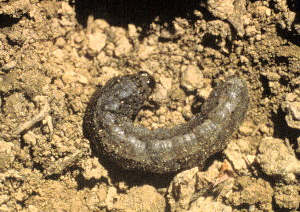Cutworms in Kentucky Soybean
ENTFACT-132: Cutworms in Kentucky Soybean | Download PDF
Agrotis sp. (Lepidoptera: Noctuidae)
by Doug Johnson, Extension Entomologist
University of Kentucky College of Agriculture
Cutworms are not serious pests in soybeans but occasionally can cause considerable stand loss in localized areas of a field. The most common species is the black cutworm. Black cutworms may be found from plant emergence until late June. They are more likely to be found in fields with a history of cutworm damage, those planted under reduced or no-tillage practices, fair to poorly drained fields and / or ‘overflow' land, or fields covered with winter annual weeds prior to planting.

Larvae (worms) are light gray to nearly black with a faint, narrow, stripe down the middle of the back. The skin appears ‘greasy' and to contain tiny granules. Larvae vary from 1/4 inch long just after hatch to 1-1/4 to 1-3/4 inches long when full grown. They will be coiled in a compact "C" when uncovered.
Cutworms are active at night, feeding first on leaves. Larger cutworms cut small plants and may pull parts of them into their burrow. Symptoms are cut or wilted, or missing plants.
Look for stand reduction or wilted or cut plants when walking through the field. Scouting is done only if plant with these symptoms are noticed. Look for live cutworms around damaged plants. First, check under clods around the plant base. Then, dig up an area three inches in diameter and three inches deep around the plant. Use a knife blade to sift through the soil. If stand loss due to cutworms is found and live cutworms are still present, then estimate the percentage of stand loss in several areas of the field.
Control may be justified if 30% or more of the plants are lost or damaged and live cutworms are still present. If controls are warranted, then insecticides for use against cutworms maybe found in ENT-13.
The black cutworm adult is a dark grey to black moth with a dark black dagger shaped mark on the front wing. The back wing is whitish grey. Cutworm moth flight may be monitored using pheromone traps. Once moths have been detected, the appearance of the cutting damage can be predicted using a day degree model (See Entfact-112 & 123 listed below).
Other Sources of Information from Kentucky
- IPM-3 Kentucky Integrated Crop Management Manual for Soybeans
- ENT-13 Insecticide Recommendations for Soybeans
- ENTFACT-112 Using Pheromone Traps in Field Crops
- ENTFACT-123 Predicting Insect Development Using Day Degrees
Additional References
- Covel, C. V. Eastern Moths. Houghton Mifflin Co. Boston. 1984.
- Davidson, R. H.,; Lyon, W. F. Insect Pests of Farm, Garden, and Orchard. New York: John Wiley & Sons; 1979.
- Higley, L. G.;Boethel, D. J., editors. Handbook of Soybean Insect Pests. Lanham, MD: Entomological Society of America; 1994.
- Metcalf, R. L.; Metcalf, R. A. Destructive and Useful Insects. New York: McGraw-Hill, Inc. 1993.
- Pedigo, L. P. Entomology and Pest Management. New York: Macmillan Publishing Co.; 1989.
Issued: 4/00
Revised: 4/00
CAUTION! Pesticide recommendations in this publication are registered for use in Kentucky, USA ONLY! The use of some products may not be legal in your state or country. Please check with your local county agent or regulatory official before using any pesticide mentioned in this publication.
Of course, ALWAYS READ AND FOLLOW LABEL DIRECTIONS FOR SAFE USE OF ANY PESTICIDE!
Photo: University of Kentucky IPM Slide Set
